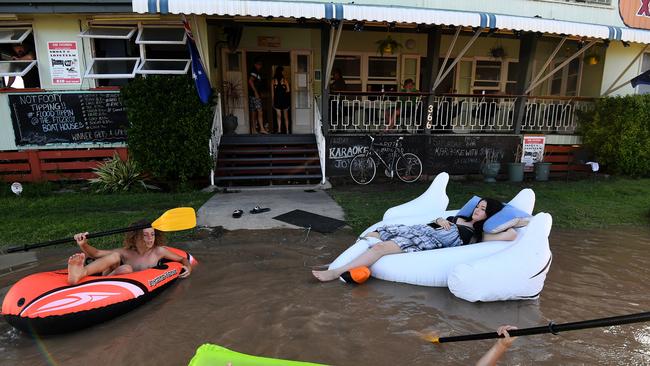Dam's releases blamed for inundation
MORE than 80 per cent of the flood in the Brisbane River resulted from a critically urgent release from the Wivenhoe Dam.
MORE than 80 per cent of the flood in the Brisbane River at its peak last Thursday was the direct result of a critically urgent release from the Wivenhoe Dam of up to a third of its entire capacity.
Data obtained by The Australian shows that, without that release, which peaked at an unprecedented rate of 645,000 megalitres a day, flooding in Brisbane would have been minimal.
Data from Wivenhoe Dam's owner and operator, the Queensland government-owned SEQWater, shows the peak flow in the Brisbane River when the river hit a height of 4.46m in the early hours of last Thursday was about 9000 cubic metres per second. Hydrologists and engineers said a release at a peak rate of 645,000ML a day would produce an estimated peak flow of almost 7500 cubic metres per second, leading to the conclusion that the flooding occurred because of the massive release from the dam.
It usually takes 36 hours for a release of water from Wivenhoe Dam to reach the city gauge in the capital. The peak release of water from the dam occurred late on Tuesday or early on Wednesday. The Brisbane River peaked in the state capital about 4am on Thursday, coinciding with a king tide.
One of the critical tasks for the commission of inquiry into the floods, announced yesterday, will be to decide if Wivenhoe's operators held on to water in the flood compartment for too long and released relatively small amounts on the weekend of January 8-9, and were forced on January 11 to start a drastic release strategy to avoid the possibility of collapse.
Engineers and hydrologists have said they could not understand why it was necessary to hold so much water since the recent establishment of southeast Queensland's water grid, with desalination plants and pipelines to ensure the region would not run out of water.
Senior Brisbane engineer Michael O'Brien, who analysed the dam's outflow for The Australian, said: "We have a dam that should have worked but we did not use it properly. It didn't work and we flooded Brisbane. That flooding did not need to occur."
Another engineer who has been examining the published data said he believed the dam had been poorly managed and that "unfortunately it has been turned into a man-made disaster".
"With saturated catchments during a strong La Nina cycle in the middle of the wet season, and with a weather bureau forecast for a significant 200-300mm rain event transpiring, the discharges from the dam over the weekend of January 8 and 9 were paltry and extremely deficient," the engineer said.
Other experts have commended the work of the dam's operators. SEQWaterGrid chief executive Barry Dennien said the dam had been run according to its operating manual and he was unable to answer further written questions because of the inquiry.
"The inquiry announcement was for me quite a surprise. I am still confident in the operation of the dam," he said.
SEQWater had contacted Mr O'Brien earlier yesterday and begun examining his written review of the dam's operations.


